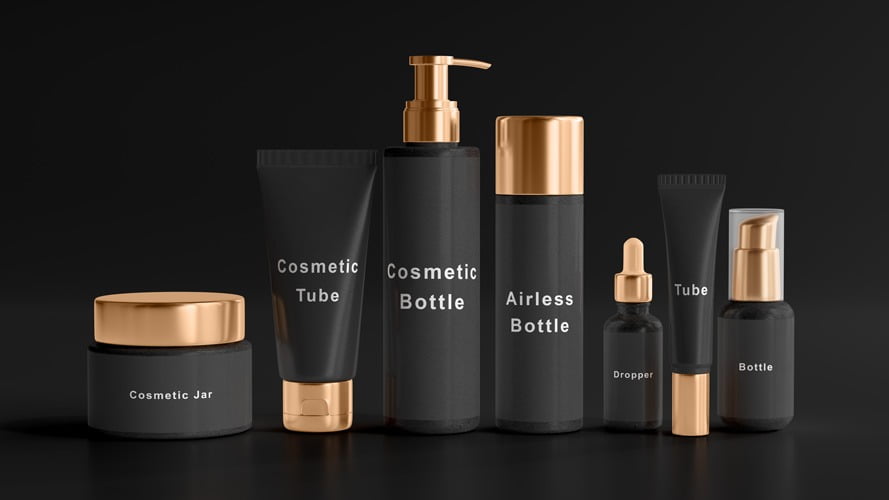8 Plastic Materials For Cosmetic Packaging You Need To Know

Founder of UKPACK, Chief Packaging Designer with 18 years of experience, Red Dot Award Winner
Specialize in custom, innovative, and sustainable packaging solutions for cosmetics, skincare, personal care, hair care, food and beverage, and more.

Cosmetics are sensitive products, so having suitable materials is very important. You never really know what issues can arise while storing or transporting cosmetic products, so you need to have adequate cosmetic packaging.
There are many options to consider here, each with its fair share of pros and cons. While it takes some trial and error to narrow down the right approach, the benefits can be excellent, mainly if you tackle this correctly. That being said, here are the primary cosmetic packaging materials you can use.
1. Acrylonitrile-butadiene-styrene (ABS)
Acrylonitrile-butadiene-styrene is a ubiquitous thermoplastic polymer. The great thing about it is that it has a significant glass transition temperature. Not only that, but it doesn’t have a melting point since it’s amorphous. That being said, it does come with excellent features like rigidity, toughness, and impact resistance. It doesn’t mess up the chemical structure of the cosmetics products makes it incredibly important.
The ABS polymers are also resistant to alkalis, aqueous acids, and other compounds. Aside from their mechanical purposes, Acrylonitrile-butadiene-styrene is also used for its electrical properties. The properties are not affected by humidity and temperature.
2. Polyethylene Terephthalate Glycol (PETG)
Polyethylene terephthalate glycol products use thermoplastic polymer resin. This compound is found in clothing fibers, but it’s also used for food and liquid containers, cosmetic packaging, thermoforming manufacturing, and many others.
Moreover, it conveys an excellent set of benefits, and the quality is always second to none. You can also find Bio-PET, which is the bio counterpart of this product. What makes this product unique is that it can protect the properties of the item in question, and at the same time, it has intrinsic viscosity.
3. Polypropylene (PP)
Polypropylene is also a thermoplastic polymer that can be used in a vast range of different applications. It comes with excellent chemical resistance, and at the same time, it’s mechanically rugged. That’s what makes it ideal for storing many items, including cosmetics. The fact that it’s similar to polyethylene is a significant plus, especially since it delivers better heat resistance and it’s also a bit harder than it too.
And to make things even better, it has a low density, so it’s not that heavy either. It also comes with proper fatigue resistance, so overall it’s a rather versatile and compelling material that everyone will enjoy using without a problem.
4. Styrene Acrylonitrile (SAN) – AKA Acrylic
This copolymer plastic has both acrylonitrile and styrene. It’s primarily used compound instead of polystyrene because it delivers excellent thermal resistance. This compound is brittle regarding mechanical behavior, but it’s also transparent, which you need to keep in mind.
The fact that you are getting a stellar glass transition temperature is beneficial. The material can resist boiling water, which shows its excellent resistance. That makes it great for protecting cosmetic packaging.
Moreover, SAN can be strengthened via rubber toughening, which is convenient.
5. Polyethylene Glycol Terephthalate (PET)
Polyethylene glycol terephthalate is a potent thermoplastic polyester resin that’s saturated. It’s made via condensing ethylene glycol as well as terephthalic acid. You can use it for bottles, cosmetic packaging, injection molded parts, etc.
Moreover, PET is known for its powerful dielectric properties and chemical resistance and is also really hard. You will notice it’s dimensionally stable, and it comes with excellent wear resistance as well.
6. High Density Polyethylene (HDPE)
High-Density Polyethylene is widely known for its originating from ethylene, a thermoplastic polymer. It has an outstanding strength-to-density ratio and can be used for plastic lumber, plastic bottles, cosmetic packaging, geomembranes, and piping that resists corrosion.
Furthermore, HDPE is more opaque and more challenging than LDPE, and it also withstands higher temperatures. It doesn’t have to worry about chemical reactions, so you will find results fascinating simultaneously. It can resist many solvents, so any pipe joints must be welded.
7. Low Density Polyethylene (LDPE)
LDPE is also a thermoplastic originating from ethylene, the first polyethylene grade created in 1933. It can withstand high temperatures for a short amount of time.
Additionally, you can find it in opaque and translucent variations. That being said, it’s very flexible and durable, making it ideal for various situations.
In addition, it also has more branching when compared to HDPE.
If you expose it to sunlight, it can generate ethylene and methane, which is why LDPE should be stored in locations without much sun exposure. It has excellent resistance against esters, bases, acids, and alcohols.
8. Styrene-methyl Methacrylate Copolymer (MS)
MS is a known transparent styrene acrylic copolymer. It’s made by combining MMA and SM.
Moreover, MS is also a transparent plastic, and it can be suitable for many scenarios, especially since it has scratch resistance and resists extreme weather conditions.
On top of that, you get clarity and hardness, and you will be impressed that it’s widely used worldwide with great success.
Conclusion
As you can see, there are a plethora of materials that can be used for cosmetic packaging. That’s why it’s essential to understand the properties of every material and see which one suits your needs the most. It’s incredible because it brings in front high-tier results, and the value can be second to none.
The most important thing here is that these are versatile materials, and many offer a large amount of flexibility. That makes them a perfect option for cosmetic packaging and other similar solutions. Give them a try and see which one fits your needs the most!